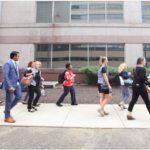 SmithBucklin, based in Chicago and Washington D.C., pressed its home-court advantage last January when Convening Leaders 2015 was held at McCormick Place in Chicago. All told, the association-management giant sent 15 planners and exhibition and education specialists from the local office to the conference.
SmithBucklin, based in Chicago and Washington D.C., pressed its home-court advantage last January when Convening Leaders 2015 was held at McCormick Place in Chicago. All told, the association-management giant sent 15 planners and exhibition and education specialists from the local office to the conference.
Before the meeting, “We brought all of the in-person participants together and talked about what they were interested in attending, and we saw if there were overlaps,” said Carol McGury, SmithBucklin’s executive vice president for event and education services. “And then we tried to divide and conquer,” attending as many different education sessions as possible. (There was one exception: “Everybody loves Jeff Hurt from Velvet Chainsaw…. We’re huge fans of their newsletter. Our entire education team went to that session.”)
It’s what SmithBucklin did after the conference, however, that’s helping make what they learned there spread and stick. The company has regular forums where employees make presentations about what they learned elsewhere, which are followed by highly interactive discussions about how ideas can be applied at the meetings they themselves manage.
 Here are some of SmithBucklin’s favorite takeaways from Convening Leaders:
Here are some of SmithBucklin’s favorite takeaways from Convening Leaders:
Surprises ROCK. Random Offers of Conference Kindness (ROCKs) are gestures the organizers make to attendees whom they catch taking actions that benefit the conference experience for everyone. ROCKs can range from simply covering an attendee’s taxi fare or offering surprise treats during a break to a suite upgrade or hotel-room comp. To make it even more fun, give guests ribbons that say, “I got ROCKED!”
Welcome to the neighborhood. The Convening Leaders welcome reception at the Museum of Science and Industry, sponsored by Choose Chicago, welcomed conference-goers by showcasing the food and culture of Chicago’s neighborhoods.” Clients can’t often afford to do that on such a grand scale, McGury said. “But for one of our events — and it happened to be in Chicago — we did do the neighborhoods of Chicago, and it worked great. We brought in a beer vendor who did some local brews and did little tastings. We did our own version of it, and everyone loved it.”
‘Food For Thought’ luncheon. PCMA used a meal time to help Convening Leaders participants understand how to easily add gluten-free, vegetarian, vegan, and nut-free items to their own menus. “It was more of a sustainability and farm-to-table kind of concept,” McGury said. “More and more of our associations are looking for that kind of offering. We’re very much a company that is continually looking at recycling. How do we help our associations not only be more sustainable but communicate about that?”
The luncheon also highlighted the seriousness and pervasiveness of food allergies and sensitivities. “This is how many folks are gluten-free internationally,” McGury said. “It’s not just a U.S.-based issue. It’s across the world. Helping educate our team more about some of those specifics, which was really, really helpful.”
Learning from the Learning Lounge. Since PCMA launched the Learning Lounge back in 2011, the idea of creating a space where a lot of different kinds of lengths of educational sessions can take place has caught on. At SmithBucklin, “more than 50 percent of the meetings [we manage] have some sort of learning-lounge aspect,” McGury said. “That’s been adapted and changed from some of the learnings at PCMA, but we’re expanding it more and more as we start to see different visual depictions of how we might do that effectively.”
SmithBucklin-ers also learned what not to do, McGury added. “There was one thing that we noticed — and PCMA actually noted this as an area for improvement — but with everyone being focused on driving traffic to their exhibit area and having a hub in the center, a lot of the education that was in the exhibit area was excellent education, but the sound was terrible. That was actually a learning for us. You really can’t have that many sessions going on at the same time. You have to worry about the sound, the ceiling height. All of those things were just a trigger for our team to think differently about it.
 “What worked well was, [the Learning Lounge] had that larger stage over … a little bit further away, which I think was set for a larger audience,” McGury said. “We maximized that type of a setting, so having more single-focus presentations but rotating them throughout the conference cycle, so that you weren’t hosting five different things all in the center, but a little bit further away so that the volume of those presentations would not become an issue.
“What worked well was, [the Learning Lounge] had that larger stage over … a little bit further away, which I think was set for a larger audience,” McGury said. “We maximized that type of a setting, so having more single-focus presentations but rotating them throughout the conference cycle, so that you weren’t hosting five different things all in the center, but a little bit further away so that the volume of those presentations would not become an issue.
“Our clients have various budgets, so we have to also manage within some of those parameters,” she said. “Some only chose to hold one specific type of session — such as a roundtable session without doing a lot of audio, or several small roundtable sessions in the center, rather having theaters kind of set up. Every one of our groups really adapted it differently, but it was more the visual aspect of the way PCMA had it set up that it was like a focal point.”
Live online hybrid. Select sessions were livestreamed during Convening Leaders — with both video and slides — and allowed remote audiences to interact with on-site speakers. And there was a complimentary rebroadcast of highlights later in the year.
Conference replay. Unedited sessions were available to participants to watch on site, with personal screens and headphones available near PCMA’s registration area.
Column wraps. Banners thanking sponsors wrapped around columns conserved space.



